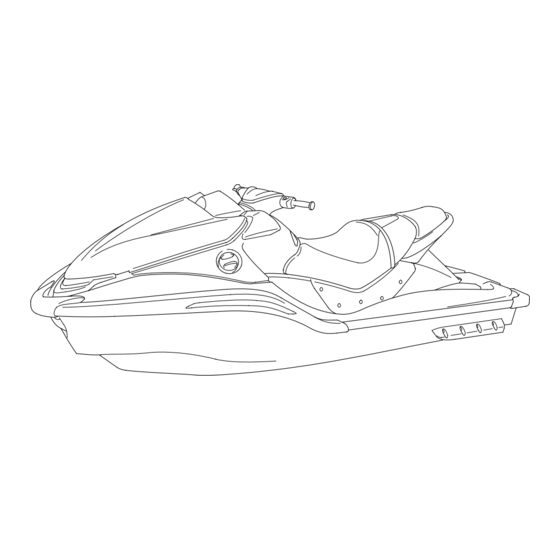Summarization of Contents
PWC Safety
Important Safety Information
Provides crucial safety information and recommendations for operating your PWC safely.
Safety Labels
Details the purpose and location of safety labels on the PWC for hazard awareness.
Instruments & Controls
Component Locations
Illustrates and identifies the location of all gauges, indicators, and controls on the PWC.
Multi-function Display
Explains the function of the multi-function display and its various indicators and readouts.
Controls & Features
Details specific controls and features like ID Lock System and Limit Mode for PWC operation.
GPScape System (ARX1500T3DX only)
Important Safety Information
Highlights critical safety warnings and precautions when using the GPScape system.
System Start-up
Details the process for acquiring a position fix and approximate response times.
GPS Mode
Describes the GPS mode for navigation, including distance and direction to waypoints.
Before Riding
Are You Ready to Ride?
Guides on ensuring personal and PWC readiness before each ride.
Operator Training
Emphasizes the importance of certified riding courses and becoming familiar with PWC operation.
Is Your PWC Ready to Ride?
Lists essential pre-ride checks for the PWC to ensure it is in safe operating condition.
Load Limits & Guidelines
Specifies maximum weight capacities and guidelines for carrying passengers and cargo.
Basic Operation & Riding
Safe Riding Precautions
Offers fundamental safety advice and operational guidelines for riding the PWC.
Starting & Stopping the Engine
Provides step-by-step procedures for starting and stopping the PWC engine safely.
Launching & Boarding Your PWC
Details safe methods for launching and boarding the PWC in various water conditions.
Turning
Explains the actions required for turning the PWC, emphasizing throttle and handlebar use.
Reverse Operation
Explains how to use the reverse lever for maneuvering the PWC.
Stopping/Docking/Beaching
Covers procedures for stopping, docking, and beaching the PWC safely.
Riding with Passengers or Cargo
Provides important considerations and safety tips when carrying passengers or cargo.
Post-ride Maintenance
Outlines essential post-ride maintenance procedures to keep the PWC in good condition.
Servicing Your Honda
Before You Service Your Honda
Covers essential information and precautions before performing any maintenance on your Honda PWC.
Service Preparations
Covers preparations needed before servicing, including tool kits and seat removal.
Service Procedures
Details various service procedures for maintaining the PWC's systems and components.
Tips
Storing Your Honda
Provides detailed procedures for storing the PWC for extended periods to maintain condition.
Transporting Your PWC
Offers guidelines and precautions for safely transporting the PWC on a trailer.
You & the Environment
Offers tips for environmentally responsible PWC ownership and operation.
Taking Care of the Unexpected
General Guidelines
Provides general guidelines and actions to take when encountering problems on the water.
If Your Engine Quits or Won’t Start
Helps diagnose and resolve issues when the PWC engine fails to start or run properly.
If Your Engine Overheats
Explains how to identify and respond to engine overheating situations.
If the Low Oil Pressure Indicator Lights
Guides on what to do if the low oil pressure indicator illuminates while riding.
If a Fuse Blows
Details how to check, replace, and troubleshoot blown fuses for the PWC's electrical system.
If You Have a Collision
Provides guidance on post-collision assessment, safety, and potential damage checks.
If Your PWC Must Be Towed
Explains procedures for safely towing the PWC to shore in various situations.
If You Capsize
Describes how to quickly right the PWC after capsizing and initial checks.
If Your PWC Is Submerged
Provides immediate steps to take if the PWC is submerged to prevent engine damage.
If the Intake or Propulsion System Is Clogged
Guides on identifying and cleaning clogged intake or propulsion systems.
If Your Battery Is Low (or Dead)
Offers advice on handling a low or dead battery, including charging precautions.
Technical Information
Vehicle Identification
Details how to identify the PWC using serial numbers, HIN, and color labels.
Specifications
Lists key dimensions, weight, fuel/lubricant capacities, and performance data.
Break-in Guidelines
Provides instructions for the initial break-in period to ensure PWC reliability and performance.
Emission Control Systems
Explains exhaust emission requirements and systems to reduce emissions.
Consumer Information
Authorized Manuals
Lists available service and owner's manuals and how to order them.
Warranty Coverage
Details the types of warranties covering the new Honda PWC and their limitations.
Warranty Service
Explains how to obtain warranty service and resolve potential misunderstandings with dealers.
Reporting Safety Defects (USA only)
Instructs on how to report safety defects to the US Coast Guard and American Honda.
Quick Reference
How To Avoid Costly Repairs
Offers tips on preventative maintenance to avoid expensive repairs and damage to the PWC.









Need help?
Do you have a question about the AQUATRAX F-15X with GPScape/F-15X/F-15 and is the answer not in the manual?
Questions and answers